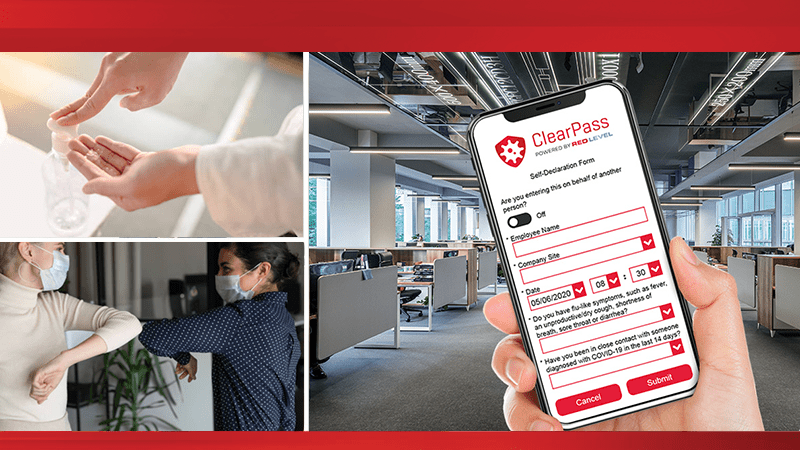We all know the basics like hand-washing and social distancing, so let’s cut to the chase and talk about some topics (and solutions) you might not have considered.
1. You can’t change human behavior, but you can nudge it.
The employee who was a germaphobe before quarantine began will likely continue to be the safest employee. The employee who throws dishes in the sink without washing them, and leaves empty containers everywhere will not likely change their behavior. Nothing will change here.
Solution: That doesn’t mean you can make it easier for employee safety. Many companies are putting touchless hand sanitizer stations (like this one) at all entrances and in the shared dining areas. Others are requiring temperature checks upon entering. This means staff trained in taking temperatures are required and that can be a significant investment in resources.
2. Don’t bother with “Who’s at risk?” assessments.
Why not? Because every employee who is at the office is at risk of contracting the virus, or carrying and spreading it to others. Period. Sure, some employees are more at risk (like sales and field operators), but it only takes one sneeze to infect everyone in the room, as many recent incidents have shown. Social distancing can be challenging a crowded office.
Solution: Rather than worry about who is and isn’t at risk, let your employees know you are worried about them. Host an employee-wide video chat and explain what the company is doing. Record the meeting and send the transcript to everyone. Be sure the transcript is accurate and includes employee questions and answer.
3. Be really careful about confidentiality, should an employee test positive.
Yes, you need to know who they have been in contact with. No, you are prohibited by law to discuss with other employees the name of the infected employee.
Solution: You will have to ask an infected employee which coworkers they were in close contact with for the past two weeks. Those employees will need to be contacted and notified, but you will need to omit names. It is a violation of an employee’s rights to openly discuss another their personal health.
4. Apps can take the heavy lifting off your hands.
Remote working has gone from something only freelancers did to something we all do. Some employees will need to continue to work from home — especially parents of young children. Queueing, contract tracing, and location capacity are topics few of us considered when starting our businesses, but they are a new reality putting extra stress on your resources.
Solution: Apps can help with the new constraints put on businesses. At Red Level, we developed our own app internally (ClearPass) for use with our employees. We are giving it away to any firm who needs to easily manage these critical services. You can download it here. The app is free forever.
5. Rotate your return, but don’t rush it.
When determining how to bring employees back it’s good to look at how other companies are handling it.
Google is returning employees back in what they term a, “gradual, phased approach.” Employees will be brought back on a rotation basis, first only filling to 10% capacity, starting with employees who have to be physically present, and adding employees who want to be back. Their plan is to be up to 30% capacity by September.
GM had its phased reopening plan leaked by employees:
- Phase 1: As of May 18, employees who must work on-site can work a limited number of hours per week in the office.
- Phase 2: Employees who feel they work better in the office can begin working a limited number of days per week. As of this writing, this had not begun.
- Phase 3: Employees who work remotely will be allowed to return.
- Phase 4: Finally, in phase four, all employees resume normal work schedules.
6. Some employees just aren’t ready to return to work.
One of the biggest myths and reasons businesses resisted remote working for so long was that employees would just watch TV and goof around all day. But the reverse has always been true. Forbes says, “Employees who work from home tend to be more productive and experience less work-family conflict. Collaboration also does not seem to suffer.”
But some employees may not be ready to return and you should respect their fears — if they are willing to work to their normal capacity at — and their work is not dependent on their physical presence. Some employees may be in high risk groups, may now have people to care for at home that they didn’t previously, or may feel the risks outweigh the benefits.
Solution: The best thing you can do as an employer is to reassure everyone you understand their situation and to take extra time if they need it. Threatening employees to return is the worst course of action and will only serve to diminish morale and productivity.
7. Roll out your plan and make it mandatory through a form.
You may have a reopening plan written and be ready to release it, but there are a few things that can go wrong, such as employees not getting the plan (or claiming not to) because it was only sent out in one format, or not comprehending the plan.
Solutions:
- All employees need to know your plan ASAP.
- Make it available in multiple formats and channels so you don’t have the “I never got the memo/email/text” excuse.
- Don’t assume that one format is enough. A video may get more views than a memo, but unless you provide captions, your hearing-impaired employees will not understand it.
- The best solution is to notify employees through multiple channels that a mandatory form is coming with the company’s official stance and rules on reopening.
- Employees must check a box that they read and understood the plan before submitting. Have your developer make that a mandatory checkbox before submission can occur.
- And please ensure the plan is not written for PhDs — not all of your staff have the same comprehension levels.
8. What happens when an employee tests positive?
It is our nature as employers to want to fix things and have all the answers. But in this case, you’re not, and giving out medical advice could literally kill your employees.
Solution: The Harvard Business Review simply said, “Don’t speculate. You are not a doctor, Instead, refer them to their own physician and to the CDC website. What you can do is reassure them that the company, and you, will be supportive.”
9. My older employees won’t want to return to work.
Forbes published an informative piece with an unexpected insight: Employees in high-risk demographics were no more likely to want to stay home than those in healthier demographics. However, employees in multigenerational or minority households were afraid to return to work because they are nervous about infecting family members.
Solution: You may need to allow some employees to stay home a bit longer — on the condition that their work quality and efficiency doesn’t change. Don’t assume. Take internal polls and get actual employee data on what they feel.
References:
Cohn, Alisa. “Your Employee Tested Positive for Covid-19. What Do You Do?” Harvard Business Review, Harvard Business Publishing, 17 Apr. 2020, hbr.org/2020/03/your-employee-tested-positive-for-covid-19-what-do-you-do.
Fellows, University of Houston Energy. “American Offices Are Reopening. Many Employees Aren’t Ready.” Forbes, Forbes Media, LLC, 27 May 2020, https://www.forbes.com/sites/uhenergy/2020/05/27/american-offices-are-reopening-many-employees-arent-ready/.
Fernandez, Ryan. “How Google Is Getting Ready to Bring Googlers Back into the Office.” Bizjournals.com, American City Business Journals., 27 May 2020, 8:30AM, https://www.bizjournals.com/sanjose/news/2020/05/27/google-office-reopen-plan-goog.html.
King, David. “COVID ClearPass App from Red Level Group.” Red Level Group, Red Level Group, 11 May 2020, https://redlevelgroup.com/contact-red-level/clearpass/.
LaReau, Jamie L. “How GM Plans to Bring White-Collar Employees Back into Workforce.” Detroit Free Press, Detroit Free Press, 26 May 2020, 5:22PM, https://www.freep.com/story/money/cars/general-motors/2020/05/26/gm-salaried-workers-coronavirus/5258572002/.
Mishra, Devjani, et al. “Coronavirus (COVID-19) Employer FAQs.” Littler Mendelson P.C., 9 Apr. 2020, www.littler.com/publication-press/publication/coronavirus-covid-19-employer-faqs.
Walsh, Kate, and Nikhil Sahni. “Adapting Healthcare to COVID-19: An Interview with the CEO of Boston Medical Center.” McKinsey & Company, 26 May 2020, https://www.mckinsey.com/industries/healthcare-systems-and-services/our-insights/adapting-healthcare-to-covid-19-an-interview-with-the-ceo-of-boston-medical-center.
For more information about gaining a competitive advantage with digital transformation, contact Red Level today.
Related Posts
Mergers and acquisitions (M&A) are exciting, on paper. In reality? ...
As we step into 2024, the landscape of IT is ...
What article on artificial intelligence is complete without a linguistics ...





